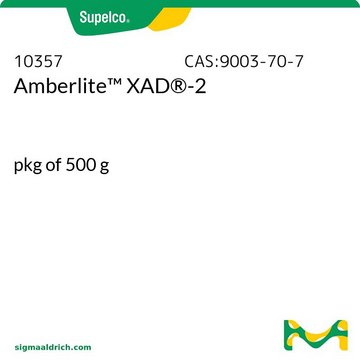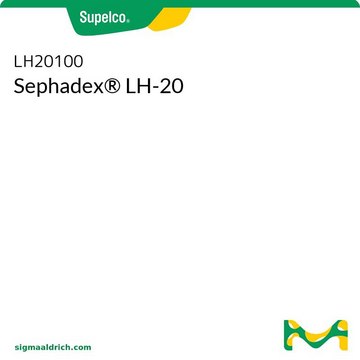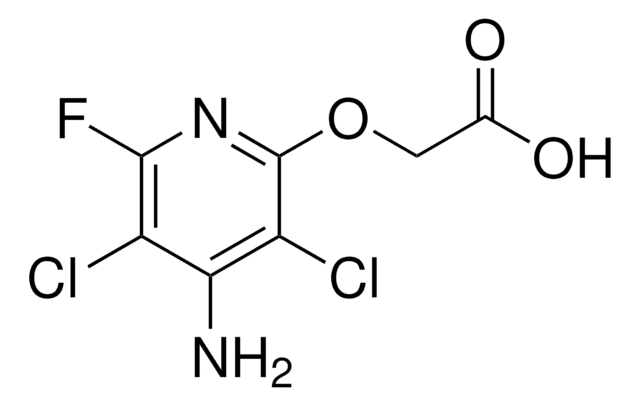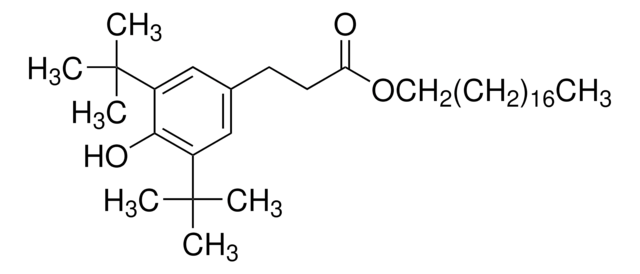13623-U
Sepabeads® SP-207 Polymeric Adsorbent
20-60 mesh, bucket of 1000 g
Sign Into View Organizational & Contract Pricing
All Photos(1)
About This Item
Recommended Products
Product Name
Sepabeads® SP-207, bucket of 1000 g
form
solid
Quality Level
packaging
bucket of 1000 g
technique(s)
LPLC: suitable
surface area
650 m2/g
matrix
brominated styrene-divinylbenzene
matrix active group
polymer
particle size
20-60 mesh
pore size
~1.20 mL/g pore volume
105 Å mean pore size
density
1.18 g/mL at 25 °C (true wet)(lit.)
separation technique
reversed phase
Related Categories
General description
Sepabeads® SP-207 is a nonionic polystyrene-divinylbenzene polymer resin used as column packing material. It is widely used as a adsorbent for purification in biopharmaceutical applications.
Application
- Sepabeads® SP-207 was used in kinetic and thermodynamics investigation for adsorption/desorption behavio of anthocyanin pigments.
- Sepabeads® SP-207 was used as column packing material for purification of phenolic fraction.
Dense resin popular for collecting hydrophobic compounds from thick fermentation broths. The bromination makes it superior to styrene-divinylbenzene polymers: strongly hydrophobic, high density, large capacity. Especially useful with upflow fluidized bed applications.
Other Notes
Swelling in toluene = 18%
Legal Information
Diaion is a registered trademark of Mitsubishi Chemical Corp.
Sepabeads is a registered trademark of Mitsubishi Chemical Corp.
Storage Class Code
11 - Combustible Solids
WGK
WGK 3
Flash Point(F)
Not applicable
Flash Point(C)
Not applicable
Personal Protective Equipment
dust mask type N95 (US), Eyeshields, Gloves
Choose from one of the most recent versions:
Already Own This Product?
Find documentation for the products that you have recently purchased in the Document Library.
An optimal extraction solvent and purification adsorbent to produce anthocyanins from black rice (Oryza sativa cv. Heugjinjubyeo).
Kang, You Jin, Seung Won Jung, and Seung Ju Lee.
Food Technology and Biotechnology, 23, 97-106 (2014)
Irena Palíková et al.
Journal of agricultural and food chemistry, 57(15), 6584-6589 (2009-07-04)
The effect of Lonicera caerulea L. (blue honeysuckle) phenolic fraction (18.5% anthocyanins) on cell viability and against oxidative damage in low density lipoproteins (oxLDL), in rat microsomes and in primary cultures of rat hepatocytes and human umbilical vein endothelial cells
Renáta Myjavcová et al.
Journal of chromatography. A, 1217(51), 7932-7941 (2010-11-30)
Anthocyanins from the fruit Lonicera caerulea L. var. kamtschatica (blueberry honeysuckle, Caprifoliaceae) were studied via (semi)preparative chromatographic fractionation followed by MS and μLC/MS analysis. The extraction procedure was optimized with respect to analytical purposes as well as its potential use
Our team of scientists has experience in all areas of research including Life Science, Material Science, Chemical Synthesis, Chromatography, Analytical and many others.
Contact Technical Service






